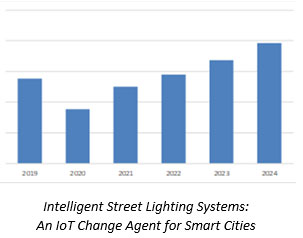

Lights are ubiquitous and are found illuminating infrastructure such as parking lots, campuses, parks, and streets. Intelligent street lighting systems are beginning to emerge as a possible central nervous system for IoT deployments in cities. Lighting control systems have evolved in recent years to reflect the changing lighting needs of municipalities. Using the added intelligence of microprocessors, street lighting system suppliers have stretched the functionality of smart lighting systems so they can now react to operators’ specific needs while maximizing energy savings. If you are interested in more information about this market, ARC’s market analysis report for intelligent street lighting systems can be found here.

Today’s advanced street lighting systems can not only reduce energy costs, but also increase control, optimize maintenance, and serve as a platform for deploying various smart city applications. In addition, lower costs for data acquisition, edge-capable hardware, wireless technologies, and cloud-based management platforms have made intelligent lighting systems cost-effective for many small- to medium-size installations. The following strategies will help cities and vendors achieve success in the deployment of intelligent street lighting systems.
A smart city is one that has undergone a digital transformation, where communication infrastructure has been deployed via an intelligent network to address challenges within city communities. These challenges include parking, traffic, transportation, street lighting, water and waste management, safety, and security. Intelligent LED street lighting networks are proving to be a transformational force in smart cities, providing an affordable option for cities to deploy an IoT platform that is delivering real quantifiable results.
Control systems with a multitude of microprocessors and networking components are at the heart of every smart lighting network. A cyber compromise of any one of these control system elements could have serious consequences, including operational disruptions and safety incidents. As lighting control becomes ubiquitous, the cyber threats go well beyond controlling lights themselves such as changing stoplights or cutting out airport runway lights or causing a city’s streets to go dark, which are life-threatening situations. IoT is disrupting traditional security practices and addressing the new requirements of IoT architectures from a cyber-secure perspective will be a crucial component of success in a connected future.
ARC sees the extraordinary growth potential for LED-based neural networks in smart cities worldwide, but like advanced manufacturing and any market going forward in a connected world there are concerns with a lack of available qualified personnel. Acquiring innovative startups and small- to mid-size companies is the fastest way to infuse talent and market-ready solutions into your organizations.
This could work for all parties involved in this industry in several ways. Global automation vendors have been challenged by mature markets and have been struggling to achieve growth. The foray of global automation vendors into building automation has allowed them to build significant market share in traditional markets of HVAC, fire & life safety, as well as access control. If these vendors target this market, they bring significant value and the power to accelerate the transition to ubiquitous smart lighting. The industrial automation vendors have the integration skills and technical expertise gained from the digital transformation of the industrial markets for more than a decade. Industrial vendors also have global brand power, marketing teams, large R&D budgets, cash-on-hand for acquisitions, and global networks of system integration partners.

